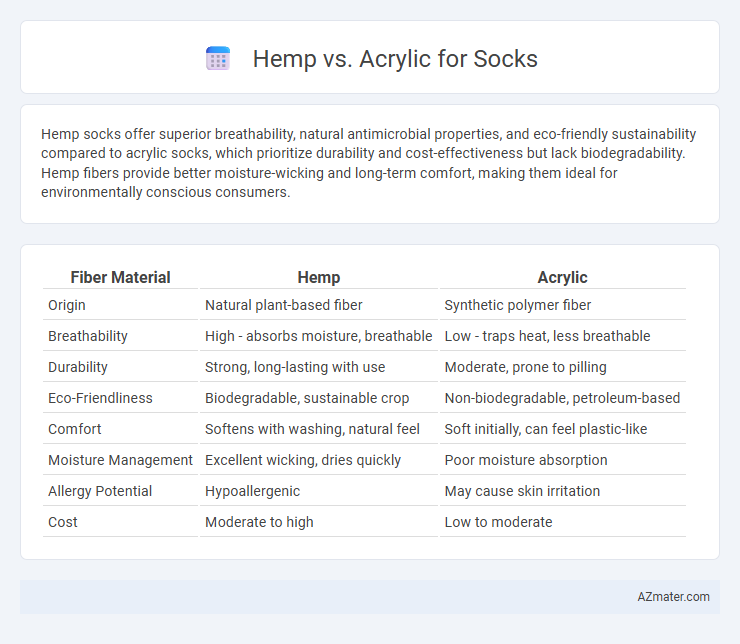Hemp socks offer superior breathability, natural antimicrobial properties, and eco-friendly sustainability compared to acrylic socks, which prioritize durability and cost-effectiveness but lack biodegradability. Hemp fibers provide better moisture-wicking and long-term comfort, making them ideal for environmentally conscious consumers.
Table of Comparison
| Fiber Material | Hemp | Acrylic |
|---|---|---|
| Origin | Natural plant-based fiber | Synthetic polymer fiber |
| Breathability | High - absorbs moisture, breathable | Low - traps heat, less breathable |
| Durability | Strong, long-lasting with use | Moderate, prone to pilling |
| Eco-Friendliness | Biodegradable, sustainable crop | Non-biodegradable, petroleum-based |
| Comfort | Softens with washing, natural feel | Soft initially, can feel plastic-like |
| Moisture Management | Excellent wicking, dries quickly | Poor moisture absorption |
| Allergy Potential | Hypoallergenic | May cause skin irritation |
| Cost | Moderate to high | Low to moderate |
Introduction: Hemp vs Acrylic Socks
Hemp socks offer natural breathability, moisture-wicking properties, and durability, making them an eco-friendly choice for everyday wear. Acrylic socks provide a soft, lightweight feel with excellent insulation and color retention, often favored for warmth and vibrant designs. Comparing hemp and acrylic socks reveals distinct benefits in sustainability, comfort, and performance, guiding consumers toward their preferred material based on lifestyle needs.
Material Origins and Sustainability
Hemp socks originate from the natural fibers of the Cannabis sativa plant, known for its rapid growth and minimal need for pesticides or synthetic fertilizers, making it a highly sustainable material. Acrylic socks are made from synthetic polymers derived from petroleum, involving energy-intensive manufacturing processes with a larger carbon footprint and limited biodegradability. Choosing hemp over acrylic supports eco-friendly practices by reducing reliance on fossil fuels and promoting biodegradable, renewable resources in textile production.
Environmental Impact Comparison
Hemp socks have a significantly lower environmental impact compared to acrylic socks due to hemp's natural biodegradability and minimal water and pesticide requirements during cultivation. Acrylic fibers are synthetic, derived from petroleum, and contribute to microplastic pollution in waterways when washed. Choosing hemp socks supports sustainable agriculture practices and reduces dependence on fossil fuels, making them an eco-friendly alternative to acrylic.
Comfort and Softness
Hemp socks offer natural breathability and moisture-wicking properties, making them ideal for comfortable wear in warm conditions. Acrylic fibers provide a soft, lightweight feel with excellent cushioning and warmth, suitable for cooler environments. While hemp is more durable and eco-friendly, acrylic socks emphasize softness and plush comfort for sensitive skin.
Breathability and Moisture-Wicking Properties
Hemp socks offer superior breathability due to their natural fiber structure, allowing better airflow and keeping feet cooler and drier. The highly absorbent nature of hemp enhances moisture-wicking properties, drawing sweat away from the skin more effectively than acrylic fibers. Acrylic socks, while durable and lightweight, generally provide less breathability and moisture management compared to hemp, making hemp a preferred choice for maintaining dry, comfortable feet.
Durability and Longevity
Hemp fibers offer superior durability and longevity for socks due to their high tensile strength and natural resistance to wear and tear, often lasting significantly longer than acrylic alternatives. Acrylic socks tend to degrade faster with frequent washing and heavy use, losing shape and softness more quickly. Choosing hemp ensures a sustainable, long-lasting sock that maintains its integrity through extensive use.
Allergen Potential and Skin Sensitivity
Hemp fibers naturally possess hypoallergenic properties and antimicrobial benefits, making them ideal for individuals with sensitive skin or allergies. Acrylic fibers, derived from synthetic polymers, often cause irritation or allergic reactions due to chemical additives and lower breathability. Choosing hemp socks reduces the risk of skin irritation and enhances comfort for allergy-prone users.
Warmth and Insulation Factors
Hemp fibers offer excellent breathability and natural insulation, making hemp socks ideal for regulating temperature and keeping feet warm yet dry during moderate conditions. Acrylic socks provide superior warmth retention due to their synthetic composition, offering better insulation in colder environments by trapping heat more efficiently. Choosing between hemp and acrylic depends on the specific warmth requirements and moisture management needs, with hemp excelling in moisture-wicking and acrylic excelling in thermal insulation.
Cost and Availability
Hemp socks typically cost more than acrylic socks due to the sustainable farming practices and limited large-scale production associated with hemp fibers. Acrylic socks are widely available and affordable, benefiting from mass production and synthetic fiber manufacturing processes. Consumers seeking eco-friendly options often face higher prices and less availability with hemp compared to the budget-friendly and easily accessible acrylic alternatives.
Conclusion: Choosing the Right Material for Your Socks
Hemp socks offer superior durability, breathability, and natural antibacterial properties, making them ideal for eco-conscious consumers seeking comfort and sustainability. Acrylic socks provide softness, vibrant color retention, and affordability but may lack the moisture-wicking and environmental benefits of hemp. Selecting the right material depends on prioritizing sustainability and long-term wear versus budget and aesthetic preferences.

Infographic: Hemp vs Acrylic for Sock
 azmater.com
azmater.com